british
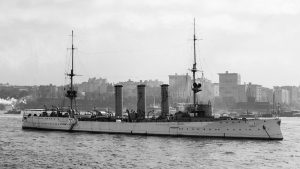 In any war, there are certain weapons, ships, planes, or vehicles that are somewhat, if not totally, feared by the enemy, and World War I was no exception. The Germans has a couple of light cruisers, the Dresden and the Emden. These cruisers were the fastest ships in the German Imperial Navy, capable of traveling at speeds of up to 24.5 knots. They weighed in at 3,600 tons, and they were two of the first German ships to be built with modern steam-turbine engines. The British actually had faster ships, but the Dresden had managed to avoid them…until March 14, 1915, that is. The Dresden was put in service in 1909, and kept very busy. Between August 1, 1914 and March 1915 the Dresden traveled over 21,000 miles.
In any war, there are certain weapons, ships, planes, or vehicles that are somewhat, if not totally, feared by the enemy, and World War I was no exception. The Germans has a couple of light cruisers, the Dresden and the Emden. These cruisers were the fastest ships in the German Imperial Navy, capable of traveling at speeds of up to 24.5 knots. They weighed in at 3,600 tons, and they were two of the first German ships to be built with modern steam-turbine engines. The British actually had faster ships, but the Dresden had managed to avoid them…until March 14, 1915, that is. The Dresden was put in service in 1909, and kept very busy. Between August 1, 1914 and March 1915 the Dresden traveled over 21,000 miles.
In the summer of 1914, the Dresden was patrolling the Caribbean Sea. Its assignment was to safeguard German investments and German citizens living abroad in the region. Then, on July 20, during a bitter civil war in Mexico, the Dresden was called upon to give safe passage to Mexican president, Victoriano Huerta, by transporting him and his family as they escaped to Jamaica, where they received asylum from the British government. Then came news from Europe of Austria’s ultimatum to Serbia and the imminent possibility of war. The German’s put the fleet on alert. By the first week of August the nations of Europe were at war. The Dresden was sent to South America to attack British shipping interests there, and it sunk several merchant ships as it traveled to Cape Horn, at the southern tip of Chile. The Dresden eluded the British naval squadron in 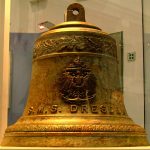 the region, commanded by Rear Admiral Sir Christopher Cradock. In October, the ship joined Admiral Maximilian von Spee’s German East Asia Squadron at Easter Island in the South Pacific. On November 1, Spee’s squadron, including Dresden, scored a crushing victory over the British in the Battle of Coronel, sinking two cruisers with all hands aboard, including Cradock, who went down with his flagship, Good Hope.
the region, commanded by Rear Admiral Sir Christopher Cradock. In October, the ship joined Admiral Maximilian von Spee’s German East Asia Squadron at Easter Island in the South Pacific. On November 1, Spee’s squadron, including Dresden, scored a crushing victory over the British in the Battle of Coronel, sinking two cruisers with all hands aboard, including Cradock, who went down with his flagship, Good Hope.
Just five weeks later, the Dresden was the only German ship to escape destruction at the Battle of the Falkland Islands on November 8, when the British light cruisers Inflexible and Invincible, commanded by Sir Doveton Sturdee, sank four of von Spee’s ships. Lost were Scharnhorst, Gneisenau, Leipzig and Nurnberg. As a crew member of Dresden wrote later of watching one of the other ships sink, “Each one of us knew he would never see his comrades again, no one on board the cruiser can have had any illusions about his fate.” Then the Dresden escaped under cover of bad weather south of the Falkland Islands.
Dresden consistently avoided capture by the British navy over the next several months, while sinking a number of cargo ships and then seeking refuge in the network of channels and bays in southern Chile. In need of repairs, the Dresden put into an island off the Chilean coast, in Cumberland Bay on March 8th. Captain, Fritz Emil von Luedecke, had decided the repairs were necessary in the wake of such heavy and extended use. Captain von Luedecke sent out many messages asking for fuel in the hopes of reaching any passing coal ships in the area, but the messages were picked up the British ships, Kent and Glasgow six days later. After a 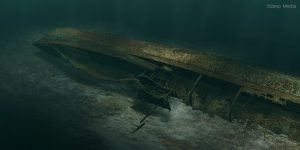 hurried search, Kent and Glasgow found Dresden. When Kent opened fire, Dresden sent a few shots back, but soon raised the white flag of surrender. They knew they had no chance against the Kent in their current condition. A German representative negotiated a truce with the British sailors to stall for time, and von Luedecke ordered his crew to abandon the ship and scuttle it. Dresden sank slowly at first, then sharply listed to the side. Amid cheers from both the British on board their two ships and the German sailors that had escaped onto land, Dresden disappeared beneath the water, its German ensign flag flying. It was a sad ending to the five year, 21,000-mile career of one of Germany’s most famous World War I commerce-raiding ships.
hurried search, Kent and Glasgow found Dresden. When Kent opened fire, Dresden sent a few shots back, but soon raised the white flag of surrender. They knew they had no chance against the Kent in their current condition. A German representative negotiated a truce with the British sailors to stall for time, and von Luedecke ordered his crew to abandon the ship and scuttle it. Dresden sank slowly at first, then sharply listed to the side. Amid cheers from both the British on board their two ships and the German sailors that had escaped onto land, Dresden disappeared beneath the water, its German ensign flag flying. It was a sad ending to the five year, 21,000-mile career of one of Germany’s most famous World War I commerce-raiding ships.
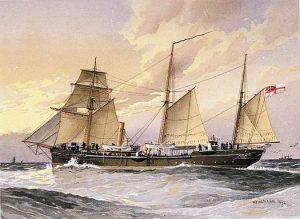 Some wars can last for years and years, while others are relatively short lived, but no war, at least to date, has been as short as the Anglo-Zanzibar War that was fought on August 27, 1896. The war was so short, that it is estimated to have lasted between 38 and 40 minutes…yes, I said minutes. The cause of the war was the sudden and unexplained death of pro-British Sultan Hamad bin Thuwaini, followed by the subsequent succession of Sultan Khalid bin Barghash, who was suspected of killing his uncle in order to take over. The British authorities preferred Hamud bin Muhammed, who was well known for his favorable stance toward British interests. A treaty signed in 1886, called for any candidate for accession to the sultanate, to be approved by the British consul, and Khalid had not fulfilled this requirement. The British considered this an act of war and sent an ultimatum to Khalid demanding that he order his forces to stand down and leave the palace. In response, Khalid called up his palace guard and barricaded himself inside the palace.
Some wars can last for years and years, while others are relatively short lived, but no war, at least to date, has been as short as the Anglo-Zanzibar War that was fought on August 27, 1896. The war was so short, that it is estimated to have lasted between 38 and 40 minutes…yes, I said minutes. The cause of the war was the sudden and unexplained death of pro-British Sultan Hamad bin Thuwaini, followed by the subsequent succession of Sultan Khalid bin Barghash, who was suspected of killing his uncle in order to take over. The British authorities preferred Hamud bin Muhammed, who was well known for his favorable stance toward British interests. A treaty signed in 1886, called for any candidate for accession to the sultanate, to be approved by the British consul, and Khalid had not fulfilled this requirement. The British considered this an act of war and sent an ultimatum to Khalid demanding that he order his forces to stand down and leave the palace. In response, Khalid called up his palace guard and barricaded himself inside the palace.
At 9:00am East Africa Time on 27 August, the ultimatum expired. The British had gathered three cruisers, two gunboats, 150 marines and sailors, and 900 Zanzibaris in the harbor area. The Royal Navy contingent were 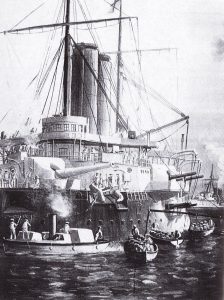 under the command of Rear-Admiral Harry Rawson while their Zanzibaris were commanded by Brigadier-General Lloyd Mathews of the Zanzibar army, who was also the First Minister of Zanzibar. Around 2,800 Zanzibaris defended the palace, most of whom were recruited from the civilian population, but they also included the sultan’s palace guard and several hundred of his servants and slaves. The defenders had several artillery pieces and machine guns, which were set in front of the palace sighted at the British ships. The first bombardment, launched at 9:02am quickly set the palace on fire, disabling the defending artillery. A small naval action took place in the harbor, with the British sinking the Zanzibari royal yacht HHS Glasgow and two smaller vessels. The palace fired some shots ineffectually at the pro-British Zanzibari troops as they approached the palace. The flag at the palace was shot down and fire ceased at 9:40am. It was almost a matter of ready…aim…oh, never mind.
under the command of Rear-Admiral Harry Rawson while their Zanzibaris were commanded by Brigadier-General Lloyd Mathews of the Zanzibar army, who was also the First Minister of Zanzibar. Around 2,800 Zanzibaris defended the palace, most of whom were recruited from the civilian population, but they also included the sultan’s palace guard and several hundred of his servants and slaves. The defenders had several artillery pieces and machine guns, which were set in front of the palace sighted at the British ships. The first bombardment, launched at 9:02am quickly set the palace on fire, disabling the defending artillery. A small naval action took place in the harbor, with the British sinking the Zanzibari royal yacht HHS Glasgow and two smaller vessels. The palace fired some shots ineffectually at the pro-British Zanzibari troops as they approached the palace. The flag at the palace was shot down and fire ceased at 9:40am. It was almost a matter of ready…aim…oh, never mind.
Sultan Khalid bin Barghash’s forces sustained roughly 500 casualties, while the British only had one sailor injured. Sultan Khalid immediately ran to the German consulate, where he was given asylum and then he escaped to German East Africa, located in the mainland part of present day Tanzania. The British quickly placed Sultan Hamud bin Muhammed in power at the head of a puppet government. The war marked the end of the Zanzibar Sultanate as a sovereign state and the start of a period of heavy British influence. The badly damaged palace complex was completely changed by the war. The harem, lighthouse and palace were demolished as the 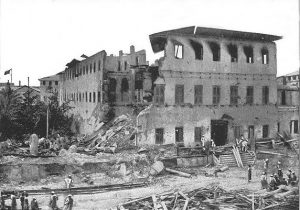 bombardment had left them unsafe. The palace site was turned into an area of gardens, and a new palace was erected on the site of the harem. The House of Wonders was almost undamaged and would later become the main secretariat for the British governing authorities. During renovation work on the House of Wonders in 1897, a clock tower was added to its frontage to replace the lighthouse lost to the shelling. The wreck of the Glasgow remained in the harbor in front of the palace, where the shallow waters ensured that her masts would remain visible for several years to come, as a reminder of what would happen if the treaty was not followed. In 1912, it was finally broken up for scrap.
bombardment had left them unsafe. The palace site was turned into an area of gardens, and a new palace was erected on the site of the harem. The House of Wonders was almost undamaged and would later become the main secretariat for the British governing authorities. During renovation work on the House of Wonders in 1897, a clock tower was added to its frontage to replace the lighthouse lost to the shelling. The wreck of the Glasgow remained in the harbor in front of the palace, where the shallow waters ensured that her masts would remain visible for several years to come, as a reminder of what would happen if the treaty was not followed. In 1912, it was finally broken up for scrap.
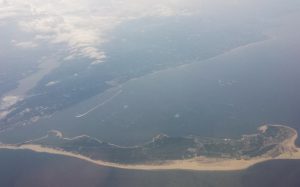
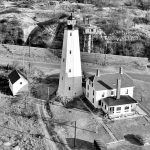 Most of us have heard the name Sandy Hook because of the school shooting that took place in an elementary school with the same name in Newtown, Connecticut. That tragedy was not the first time the name Sandy Hook had been at the center of attention, however. Most people know that along United States coastal areas, there are many lighthouses. The lighthouses might not be so necessary these days, because of GPS tracking, but before all of the technology that we have today, lighthouses were the only way for a ship to know if they were coming dangerously close to a stretch of land. Such was the case with the Sandy Hook lighthouse in 1776. The problem they were having with the lighthouse, however, is that it was thought that the lighthouse would also help the British ships to invade New York City. It was a very real concern, and posed a grave danger to the Provincial Congress of New York.
Most of us have heard the name Sandy Hook because of the school shooting that took place in an elementary school with the same name in Newtown, Connecticut. That tragedy was not the first time the name Sandy Hook had been at the center of attention, however. Most people know that along United States coastal areas, there are many lighthouses. The lighthouses might not be so necessary these days, because of GPS tracking, but before all of the technology that we have today, lighthouses were the only way for a ship to know if they were coming dangerously close to a stretch of land. Such was the case with the Sandy Hook lighthouse in 1776. The problem they were having with the lighthouse, however, is that it was thought that the lighthouse would also help the British ships to invade New York City. It was a very real concern, and posed a grave danger to the Provincial Congress of New York.
The Sandy Hook lighthouse was located on a piece of land that was disputed territory in those days. The land sits directly across the bay from New York City, making it an important shipping lane, but a dangerous one too. In early 1761, the Provincial Congress of New York set up lotteries to raise money for the construction of a lighthouse. A lighthouse in this area had been under discussion for nearly a century before it was initiated by Colonial Governor Edmund Andread. Forty three New York merchants proposed the lotteries to the Provincial Council, after losing 20,000 sterling pounds to shipwrecks in 1761. The money was collected, and the Sandy Hook lighthouse was built. It first shone its beam on June 11, 1764. It served it’s purpose quite well…in fact maybe too well…at least during the Revolutionary War. Ships weren’t sinking, but in a big way, it left New York City quite vulnerable to attack. So, after just fifteen years of use, the New York Provincial Congress decided that the lighthouse had to be dismantled. Then came the controversy. A committee of the New York Provincial Congress told Major William Malcolm to “use your best discretion to render the light-house entirely useless.” They wanted him to remove the lens and lamps so that the lighthouse could no longer warn ships of possible hazards on the rocky shore. He succeeded. Colonel George Taylor reported to the committee six days later, that Malcolm had given him eight copper lamps, two tackle falls and blocks, three casks, and a part of a cast of oil from the dismantling of the beacon.
Malcolm’s efforts failed, because the lighthouse was quickly put back into service by the merchants in the area, with the installation of lamps and reflectors. The Patriots attempted to knock the light out again on June 1st, by placing cannon on boats and attempting to blow away the British paraphernalia, damaging some of it before 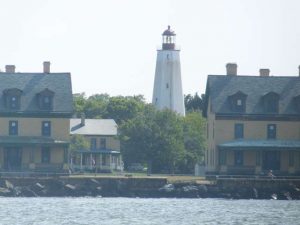
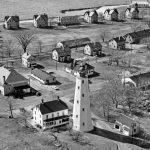 they were chased away. Malcolm’s efforts did not prevent the British from invading New York City. The new states of New York and New Jersey fought over ownership of the lighthouse until the federal government assumed control of all US lighthouses in 1787. As of 1996, the Sandy Hook lighthouse, the oldest original lighthouse in the United States, became a historic landmark, and passed into the jurisdiction of the National Park Service. It is still in operation as part of the Gateway National Recreation Area.
they were chased away. Malcolm’s efforts did not prevent the British from invading New York City. The new states of New York and New Jersey fought over ownership of the lighthouse until the federal government assumed control of all US lighthouses in 1787. As of 1996, the Sandy Hook lighthouse, the oldest original lighthouse in the United States, became a historic landmark, and passed into the jurisdiction of the National Park Service. It is still in operation as part of the Gateway National Recreation Area.
 The Indian tribes in the United States had a spoken language, but in the early years they had no real need for a written language, other than hieroglyphics. At some point, a young Cherokee man named Sequoyah noticed something about the men in Andrew Jackson’s platoon, while he and some other Cherokee men were volunteering in the fight against the British in the War of 1812. In dealing with the Anglo soldiers and settlers, Sequoyah became intrigued by their “talking leaves” or printed books. Sequoyah realized that somehow the “talking leaves” recorded human speech. In a brilliant leap of logic, Sequoyah comprehended the basic nature of symbolic representation of sounds and in 1809 he began working on a similar system for the Cherokee language. Little did Sequoyah know that his work would change things, and in fact, change life for the Cherokee people. Still, it was not without it’s downside. Sequoyah was ridiculed and misunderstood by most of the Cherokee. Nevertheless, he made slow progress until he came up with the idea of representing each syllable in the language with a separate written character. Finally, he perfected his syllabary of 86 characters, a system that could be mastered in less than week. After obtaining the official endorsement of the Cherokee leadership, Sequoyah’s invention was soon adopted throughout the Cherokee nation.
The Indian tribes in the United States had a spoken language, but in the early years they had no real need for a written language, other than hieroglyphics. At some point, a young Cherokee man named Sequoyah noticed something about the men in Andrew Jackson’s platoon, while he and some other Cherokee men were volunteering in the fight against the British in the War of 1812. In dealing with the Anglo soldiers and settlers, Sequoyah became intrigued by their “talking leaves” or printed books. Sequoyah realized that somehow the “talking leaves” recorded human speech. In a brilliant leap of logic, Sequoyah comprehended the basic nature of symbolic representation of sounds and in 1809 he began working on a similar system for the Cherokee language. Little did Sequoyah know that his work would change things, and in fact, change life for the Cherokee people. Still, it was not without it’s downside. Sequoyah was ridiculed and misunderstood by most of the Cherokee. Nevertheless, he made slow progress until he came up with the idea of representing each syllable in the language with a separate written character. Finally, he perfected his syllabary of 86 characters, a system that could be mastered in less than week. After obtaining the official endorsement of the Cherokee leadership, Sequoyah’s invention was soon adopted throughout the Cherokee nation.
Finally, it was time for the next step. The General Council of the Cherokee Nation decided to purchase a 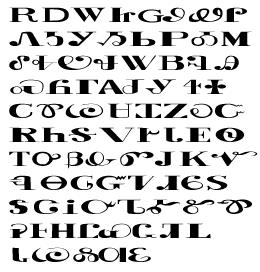 printing press. Their goal was to produce a newspaper in the Cherokee language. When the Cherokee-language printing press arrived on this day, February 21, 1828, the lead type was based on Sequoyah’s syllabary. Within months, the first Indian language newspaper in history appeared in New Echota, Georgia. It was called the Cherokee Phoenix. The Cherokee tribe was one of what the Americans called the “five civilized tribes” and they were native to the American Southeast. The Cherokee had long ago decided to embrace the United States’ program of “civilizing” Indians in the years after the Revolutionary War. In the minds of Americans, Sequoyah’s syllabary showed the Cherokee desire to fit into their dominant Anglo world. The Cherokee used their new press to print a bilingual version of the republican constitution. They also took many other steps to assimilate Anglo culture and practice while still preserving some aspects of their traditional language and beliefs. The press worked well, but would have been useless had it not been for the extraordinary work of Sequoyah.
printing press. Their goal was to produce a newspaper in the Cherokee language. When the Cherokee-language printing press arrived on this day, February 21, 1828, the lead type was based on Sequoyah’s syllabary. Within months, the first Indian language newspaper in history appeared in New Echota, Georgia. It was called the Cherokee Phoenix. The Cherokee tribe was one of what the Americans called the “five civilized tribes” and they were native to the American Southeast. The Cherokee had long ago decided to embrace the United States’ program of “civilizing” Indians in the years after the Revolutionary War. In the minds of Americans, Sequoyah’s syllabary showed the Cherokee desire to fit into their dominant Anglo world. The Cherokee used their new press to print a bilingual version of the republican constitution. They also took many other steps to assimilate Anglo culture and practice while still preserving some aspects of their traditional language and beliefs. The press worked well, but would have been useless had it not been for the extraordinary work of Sequoyah.
Sequoyah was born about 1770 in Tuskegee, Cherokee Nation, near present day Knoxville, Tennessee. He died 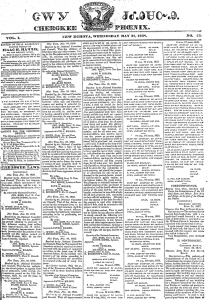 August 1843 at about 72 or 73, in San Fernando, Tamaulipas, Mexico. His name in English is George Gist or George Guess, which I find to be…well, crazy. Why was it necessary to butcher his name. Sequoyah was a Cherokee silversmith by trade, but his biggest claim to fame was the creation of written Cherokee. In 1821, when he completed his independent creation of a Cherokee syllabary, he successfully made reading and writing in Cherokee possible. This was one of the very few times in recorded history that a member of a pre-literate people created an original, effective writing system. After seeing its worth, the people of the Cherokee Nation rapidly began to use his syllabary and officially adopted it in 1825. Their literacy rate quickly surpassed that of surrounding European-American settlers. In recognition of his service, the Cherokee Nation voted Sequoyah an annual allowance in 1841. He died two years later on a trip to San Fernando, seeking Cherokee to return to Oklahoma with him. The giant California redwood tree, Sequoia, was named after him.
August 1843 at about 72 or 73, in San Fernando, Tamaulipas, Mexico. His name in English is George Gist or George Guess, which I find to be…well, crazy. Why was it necessary to butcher his name. Sequoyah was a Cherokee silversmith by trade, but his biggest claim to fame was the creation of written Cherokee. In 1821, when he completed his independent creation of a Cherokee syllabary, he successfully made reading and writing in Cherokee possible. This was one of the very few times in recorded history that a member of a pre-literate people created an original, effective writing system. After seeing its worth, the people of the Cherokee Nation rapidly began to use his syllabary and officially adopted it in 1825. Their literacy rate quickly surpassed that of surrounding European-American settlers. In recognition of his service, the Cherokee Nation voted Sequoyah an annual allowance in 1841. He died two years later on a trip to San Fernando, seeking Cherokee to return to Oklahoma with him. The giant California redwood tree, Sequoia, was named after him.
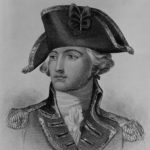 Few people think about the American Revolutionary War any more, because it was so long ago, and we have been an independent nation for so long now, that is almost seems unimportant, but nothing could be further from the truth. The strategies used then, were among the most amazing ever, when you consider the times, and the weapons available to these armies. Just moving the cannon from one place to another was a huge undertaking. Each one weighed upwards of 4500 pounds. The cannon was a major weapon, and was truly necessary if the army was to have a chance of winning a battle. Guns didn’t shoot far enough to have much safety from enemy fire. Getting close enough to successfully fight the enemy meant putting the troops at great risk, during a time when medical assistance was not readily available.
Few people think about the American Revolutionary War any more, because it was so long ago, and we have been an independent nation for so long now, that is almost seems unimportant, but nothing could be further from the truth. The strategies used then, were among the most amazing ever, when you consider the times, and the weapons available to these armies. Just moving the cannon from one place to another was a huge undertaking. Each one weighed upwards of 4500 pounds. The cannon was a major weapon, and was truly necessary if the army was to have a chance of winning a battle. Guns didn’t shoot far enough to have much safety from enemy fire. Getting close enough to successfully fight the enemy meant putting the troops at great risk, during a time when medical assistance was not readily available.
For the English, fighting on American soil was hazardous anyway. They had the disadvantage of not knowing the terrain well, so hiding places were much more well known to the Americans. The British were at a serious 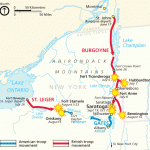 disadvantage. Then, on January 28, 1777, John Burgoyne, a poet, playwright, and British general, submitted a plan to isolate New England from the other colonies, which took in modern day New Hampshire, Massachusetts, Rhode Island and Connecticut. That area might not have been a really big area, as territories go, but it was a big undertaking for any army. Nevertheless, it was the plan that the British decided to use. Burgoyne’s plan called for 8,000 British troops from Canada to move southward through New York by way of Lake Champlain and the Mohawk River. He planned to take the Americans by surprise. General Burgoyne thought he and his troops could take control of the Hudson River and isolate New England from the other colonies.
disadvantage. Then, on January 28, 1777, John Burgoyne, a poet, playwright, and British general, submitted a plan to isolate New England from the other colonies, which took in modern day New Hampshire, Massachusetts, Rhode Island and Connecticut. That area might not have been a really big area, as territories go, but it was a big undertaking for any army. Nevertheless, it was the plan that the British decided to use. Burgoyne’s plan called for 8,000 British troops from Canada to move southward through New York by way of Lake Champlain and the Mohawk River. He planned to take the Americans by surprise. General Burgoyne thought he and his troops could take control of the Hudson River and isolate New England from the other colonies.
In his plan, the isolation of New England was designed to free British General William Howe to attack Philadelphia. Unfortunately, while the plan seemed to be working, Burgoyne miscalculated the part distance would play on his plan. His supply line was stretched in a long, narrow strip from the northern tip of Lake Champlain south to 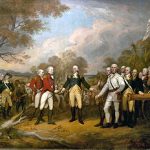 the northern curve of the Hudson River at Fort Edward, New York. As Burgoyne’s army marched south, the Patriot militia was circling north. They cut off the British supply line. What had begun as a major victory, ended up as a defeat in Bennington, Vermont, and bloody draws at Bemis Heights, New York. On October 17, 1777, a frustrated Burgoyne was forced to retreat 10 miles and finally surrendered his remaining 6,000 British forces to the Patriots at Saratoga. France, upon hearing of the Patriot victory, agreed to recognize the independence of the United States. With France’s support, the Patriots took the ultimate victory. Following the defeat at Saratoga General Burgoyne returned home in shame and defeat. He was severely criticized and soon retired from active service.
the northern curve of the Hudson River at Fort Edward, New York. As Burgoyne’s army marched south, the Patriot militia was circling north. They cut off the British supply line. What had begun as a major victory, ended up as a defeat in Bennington, Vermont, and bloody draws at Bemis Heights, New York. On October 17, 1777, a frustrated Burgoyne was forced to retreat 10 miles and finally surrendered his remaining 6,000 British forces to the Patriots at Saratoga. France, upon hearing of the Patriot victory, agreed to recognize the independence of the United States. With France’s support, the Patriots took the ultimate victory. Following the defeat at Saratoga General Burgoyne returned home in shame and defeat. He was severely criticized and soon retired from active service.
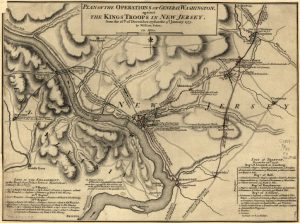 The year was 1776, and it was Christmas Day, but for the men with George Washington, it was not a day of celebration…not exactly anyway. They were in the middle of fighting a war, and the fighting didn’t just stop because it was Christmas, not this year anyway. This was to be an unusual Christmas as far as wartime Christmases went. In 1776, it was difficult to fight a war in the wintertime, because the slower modes of travel. Most times in a war, the armies took the Winter off from warring, but this army was not laying up for the Winter. This war would continue on…no matter what the weather was like.
The year was 1776, and it was Christmas Day, but for the men with George Washington, it was not a day of celebration…not exactly anyway. They were in the middle of fighting a war, and the fighting didn’t just stop because it was Christmas, not this year anyway. This was to be an unusual Christmas as far as wartime Christmases went. In 1776, it was difficult to fight a war in the wintertime, because the slower modes of travel. Most times in a war, the armies took the Winter off from warring, but this army was not laying up for the Winter. This war would continue on…no matter what the weather was like.
Things looked bad that year. The Continental Army had suffered a series of defeats in their battle against the British oppression. After some successful maneuvers, Colonel Henry Knox came to the attention of General George Washington who worked to place him in overall command to the Continental Army. Under his command, the Continentals brought 18 cannon over the river…3 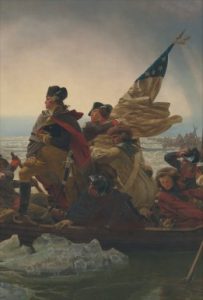 Pounders, 4 Pounders, some 6 Pounders, horses to pull the carriages, and enough ammunition for the coming battle. The 6 Pounders, weighing as much as 1,750 pounds were the most difficult to transport to the far side of the river. But in the end all the trouble of moving this large artillery train to Trenton proved its worth. Knox would place the bulk of his artillery at the top of the town where its fire commanded the center of Trenton.
Pounders, 4 Pounders, some 6 Pounders, horses to pull the carriages, and enough ammunition for the coming battle. The 6 Pounders, weighing as much as 1,750 pounds were the most difficult to transport to the far side of the river. But in the end all the trouble of moving this large artillery train to Trenton proved its worth. Knox would place the bulk of his artillery at the top of the town where its fire commanded the center of Trenton.
The plan devised by Knox and Washington was to conduct a surprise attack upon a Hessian garrison of roughly 1,400 soldiers located in and around Trenton, New Jersey. Washington hoped that a quick victory at Trenton would bolster sagging morale in his army and encourage more men to join the ranks of the Continentals in the coming new year. After several councils of war, General George Washington set the date for the river crossing for Christmas night 1776. It was an unprecedented plan, because the expectation was always that the armies would hold up somewhere for the winter. No one had attacked in winter before, and especially on Christmas. George Washington led 2,400 troops on a daring nighttime crossing of the icy Delaware River. Stealing into New Jersey, on December 26 the Continental forces launched the surprise attack on Trenton.
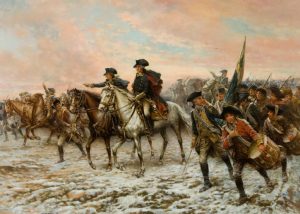 The gamble paid off. Many of the Hessians were still disoriented from the previous night’s holiday bender, and colonial forces defeated them with minimal bloodshed. While Washington had pulled off a shock victory, his army was unequipped to hold the city and he was forced to re-cross the Delaware that same day…with nearly 1,000 Hessian prisoners in tow. Washington would go on to score successive victories at the Battles of the Assunpink Creek and Princeton, and his audacious crossing of the frozen Delaware served as a crucial rallying cry for the beleaguered Continental Army. The Revolutionary War would be won by the Continental Army of course, and the rules of warfare changed forever.
The gamble paid off. Many of the Hessians were still disoriented from the previous night’s holiday bender, and colonial forces defeated them with minimal bloodshed. While Washington had pulled off a shock victory, his army was unequipped to hold the city and he was forced to re-cross the Delaware that same day…with nearly 1,000 Hessian prisoners in tow. Washington would go on to score successive victories at the Battles of the Assunpink Creek and Princeton, and his audacious crossing of the frozen Delaware served as a crucial rallying cry for the beleaguered Continental Army. The Revolutionary War would be won by the Continental Army of course, and the rules of warfare changed forever.
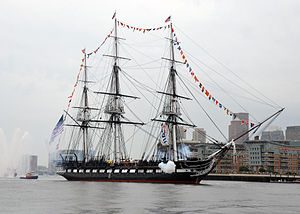 I think most of us have heard of the Barbary Coast at some point. The coast was named for its Berber inhabitants, but it was the trouble that occurred there that has made it a name to remember. The Barbary pirates, who were sometimes called Barbary corsairs or Ottoman corsairs, were pirates and privateers who operated from North Africa, mostly near the ports of Salé, Rabat, Algiers, Tunis, and Tripoli, which is now the area known as the Barbary Coast. In addition to seizing ships, they engaged in Razzias, raids on European coastal towns and villages, mainly in Italy, France, Spain, and Portugal, but also in the British Isles, the Netherlands and as far away as Iceland. Their main goal was to capture Christian slaves for the Ottoman slave trade, as well as the general Arabic market in North Africa and the Middle East. The pirates captured thousands of ships and repeatedly raided coastal towns.
I think most of us have heard of the Barbary Coast at some point. The coast was named for its Berber inhabitants, but it was the trouble that occurred there that has made it a name to remember. The Barbary pirates, who were sometimes called Barbary corsairs or Ottoman corsairs, were pirates and privateers who operated from North Africa, mostly near the ports of Salé, Rabat, Algiers, Tunis, and Tripoli, which is now the area known as the Barbary Coast. In addition to seizing ships, they engaged in Razzias, raids on European coastal towns and villages, mainly in Italy, France, Spain, and Portugal, but also in the British Isles, the Netherlands and as far away as Iceland. Their main goal was to capture Christian slaves for the Ottoman slave trade, as well as the general Arabic market in North Africa and the Middle East. The pirates captured thousands of ships and repeatedly raided coastal towns.
In order to combat the Barbary pirates, the United States Navy built the USS Constitution, which was a 44 gun 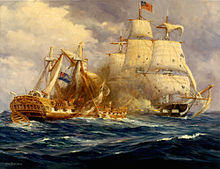 frigate. It was first launched on this day, October 21, 1797, from Boston Harbor. The USS Constitution performed well fighting off pirates in the area, and in 1805, a peace treaty was signed on her deck. When the conflict was over, the ship returned and to its base in Boston. I’m sure the pirates knew full well, that it would return if needed. The ship didn’t have to go back and flex it’s muscle again…at least not there.
frigate. It was first launched on this day, October 21, 1797, from Boston Harbor. The USS Constitution performed well fighting off pirates in the area, and in 1805, a peace treaty was signed on her deck. When the conflict was over, the ship returned and to its base in Boston. I’m sure the pirates knew full well, that it would return if needed. The ship didn’t have to go back and flex it’s muscle again…at least not there.
During the War of 1812, the USS Constitution won its nickname, Old Ironsides, after defeating the British warship, Guerriére in a furious battle off the coast of Nova Scotia. It was said that the British shots just bounced off the sides of the USS Constitution, as if they were made of iron, rather than wood, The Guerriére was thought to be invincible, but that was proven to be a fallacy. On the afternoon of 19 August 1812, about 400 miles southeast of Halifax, Nova Scotia, the Guerriére saw a sail in the distance, bearing down 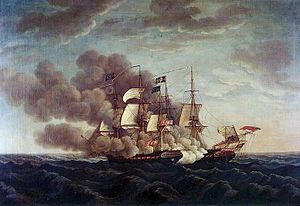 on them. It was the USS Constitution, so the Guerriére prepared for action. Captain James Dacres mustered 244 men and 19 boys, and set them to prepare for battle. When the enemy hoisted American colors, Captain Dacres permitted the Americans in his crew to quit their guns. When the fight was over, nine men were killed and thirteen were wounded. Captain Dacres surrendered his badly damaged ship in an effort to save the lives of the remaining crew, the crew were taken prisoner, and the crew of the USS Constitution set the ship on fire. That was the end of the Guerriére, and Old Ironsides was born. The USS Constitution was retired from service in 1881, and served as a receiving ship until designated a museum ship in 1907.
on them. It was the USS Constitution, so the Guerriére prepared for action. Captain James Dacres mustered 244 men and 19 boys, and set them to prepare for battle. When the enemy hoisted American colors, Captain Dacres permitted the Americans in his crew to quit their guns. When the fight was over, nine men were killed and thirteen were wounded. Captain Dacres surrendered his badly damaged ship in an effort to save the lives of the remaining crew, the crew were taken prisoner, and the crew of the USS Constitution set the ship on fire. That was the end of the Guerriére, and Old Ironsides was born. The USS Constitution was retired from service in 1881, and served as a receiving ship until designated a museum ship in 1907.
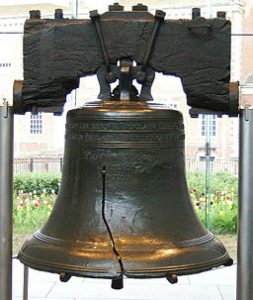 Everyone has heard of the Liberty Bell. The bell was ordered in 1751, to commemorate the 50th anniversary of Pennsylvania’s original constitution. The Pennsylvania Provincial Assembly ordered the 2,000 pound copper and tin bell. The bell was placed in the Pennsylvania State House, which is now known as Independence Hall. The bell rang out summoning citizens to the first public reading of the Declaration of Independence, by Colonel John Nixon. The document was adopted by delegates to the Continental Congress meeting in the State House on July 4th, however, the Liberty Bell, inscribed with the Biblical quotation, “Proclaim Liberty Throughout All the Land unto All the Inhabitants Thereof,” was not rung until the Declaration of Independence was returned from the printer on July 8th.
Everyone has heard of the Liberty Bell. The bell was ordered in 1751, to commemorate the 50th anniversary of Pennsylvania’s original constitution. The Pennsylvania Provincial Assembly ordered the 2,000 pound copper and tin bell. The bell was placed in the Pennsylvania State House, which is now known as Independence Hall. The bell rang out summoning citizens to the first public reading of the Declaration of Independence, by Colonel John Nixon. The document was adopted by delegates to the Continental Congress meeting in the State House on July 4th, however, the Liberty Bell, inscribed with the Biblical quotation, “Proclaim Liberty Throughout All the Land unto All the Inhabitants Thereof,” was not rung until the Declaration of Independence was returned from the printer on July 8th.
The bell was made of inferior materials, and cracked during the first test. It was recast twice and finally hung from the State House steeple in June 1753. The bell was rung on special occasions, such as when King George III ascended to the throne in 1761, and to call the people together to discuss such important things as the controversial Stamp Act of 1765. With the outbreak of the American Revolution in April 1775, the bell was rung to announce the battles of Lexington and Concord. Of course, the most famous time it was rung was July 8, 1776, when it summoned Philadelphia citizens for the first reading of the Declaration of Independence.
When the British were advancing on Philadelphia in the fall of 1777, the bell was removed and hidden in Allentown to protect it from being melted down by the British to be used for cannons. Following the defeat of the British in 1781, the bell was returned to it’s place in Philadelphia which was the nation’s capital from 1790 to 1800. In addition to marking important events, the bell was used as a part of the celebrations such as George Washington’s birthday on February 22, and Independence Day on July 4. In 1839, bell was first given it’s name when it was coined the Liberty Bell in a poem.
As to the crack that finally made the Liberty Bell unsuitable for ringing, there has been some dispute. It was 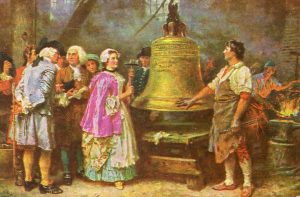 finally agreed upon that the bell suffered a major break while tolling for the funeral of the chief justice of the United States, John Marshall, in 1835, and in 1846 the crack expanded to its present size while in use to mark Washington’s birthday. After that date, it was decided that the bell was unsuitable for ringing, but it was still ceremoniously tapped on occasion to commemorate important events. On June 6, 1944, when Allied forces invaded France, the sound of the bell’s dulled ring was broadcast by radio across the United States. In 1976, the Liberty Bell was moved to a new pavilion about 100 yards from Independence Hall in preparation for America’s bicentennial celebrations. The Liberty Bell will always be a symbol of patriotism and liberty in my mind.
finally agreed upon that the bell suffered a major break while tolling for the funeral of the chief justice of the United States, John Marshall, in 1835, and in 1846 the crack expanded to its present size while in use to mark Washington’s birthday. After that date, it was decided that the bell was unsuitable for ringing, but it was still ceremoniously tapped on occasion to commemorate important events. On June 6, 1944, when Allied forces invaded France, the sound of the bell’s dulled ring was broadcast by radio across the United States. In 1976, the Liberty Bell was moved to a new pavilion about 100 yards from Independence Hall in preparation for America’s bicentennial celebrations. The Liberty Bell will always be a symbol of patriotism and liberty in my mind.
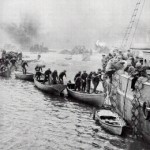 Not many disastrous wartime defeats could be declared a miraculous success, but in May of 1940, with the Germans advancing quickly toward Dunkirk the French, British, and Canadian troops were trapped between the German forces, and the English Channel. This situation was far more that a disastrous defeat, it was about to get catastrophic, because there appeared to be no way to get the Allied troops out of the way of the German forces, and the Allies were looking at the loss of thousands of soldiers, if something wasn’t done…and done quickly!!
Not many disastrous wartime defeats could be declared a miraculous success, but in May of 1940, with the Germans advancing quickly toward Dunkirk the French, British, and Canadian troops were trapped between the German forces, and the English Channel. This situation was far more that a disastrous defeat, it was about to get catastrophic, because there appeared to be no way to get the Allied troops out of the way of the German forces, and the Allies were looking at the loss of thousands of soldiers, if something wasn’t done…and done quickly!!
It was at this point that my 15th cousin 0nce removed, Winston Spencer-Churchill showed the world what a great master strategist he really was. He had warned the Allies that “the whole root, the core, and brain of the British Army” was stranded and likely to die in Dunkirk, if they didn’t come up with a way to evacuate them. A plan was devised, and given the code name, Operation Dynamo. This plan was really a God-given way of escape, where their seemed to be no way. In fact, Churchill 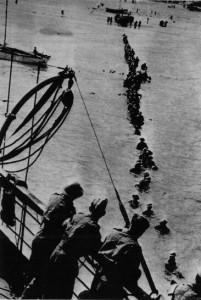 called it “a miracle of deliverance.” And so it was.
called it “a miracle of deliverance.” And so it was.
The plan used every available “ship”…right down to the smallest lifeboat. These vessels…thousands of them, many of which were manned by civilian volunteers, and each of them knew the danger they were putting themselves and their vessels in, but they bravely made the decision to participate anyway. On this day, May 26, 1940, at 19:00 hours, Vice Admiral Ramsey was given the orders and Operation Dynamo commenced. The order was given to proceed, amid information that Boulogne and Calais had been captured. This meant that the only port available was Dunkirk. Ramsey estimated that only 45,000 troops could be rescued. Lord John Galt had ordered the troops to retreat to the sea. As the Belgian army was defeated, King Leopold asked the Germans for an armistice. This dragged out the negotiations, and bought the Allies 24 hours to get their troops out.
The rescue was slow and, in fact took days. The weather prevented the Luftwaffe from attacking for a time, but that didn’t last long. Within a matter of days the weather cleatred and the Germans set out to try to stop the 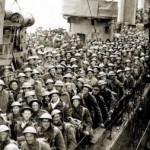 rescue that they had not realized was of the magnitude it was. From their attack, several ships wer sunk, but that still didn’t stop the seccess of the operation. By the time the last boat left Dunkirk harbor, about 338,226 soldiers (198,229 British and 139,997 French) were evacuated by a fleet of 860 boats.
rescue that they had not realized was of the magnitude it was. From their attack, several ships wer sunk, but that still didn’t stop the seccess of the operation. By the time the last boat left Dunkirk harbor, about 338,226 soldiers (198,229 British and 139,997 French) were evacuated by a fleet of 860 boats.
The evacuation was dubbed Operation Dynamo, because during World War One, Dover Castle was powered with electricity by a dynamo located beneath the castle. The castle was used as naval headquarters during World War Two, and the dynamo room is where British Vice-Admiral Bertram Ramsay planned the Dunkirk rescue mission. It is also the place where Ramsay briefed Churchill while rescue efforts were underway.
 After Bob and I had the opportunity to view the old minesweeper, now located off Picnic Park near Edmonds, Washington, I have been curious about mines and minesweepers, in general. That said, I did a little research on them, and was surprised at what I found. Landmines have been in existence since the early Ming Dynasty in the 1400s. It seems such a strange thing to me to set explosives in areas where they could not only trigger an explosion when an enemy crosses paths with them, but they could also trigger explosions when their own citizens crossed paths with them. I suppose those accidental friendly hits would be considered collateral damage, and were acceptable losses in the grand scheme of things, but it still seems like a horrible way to guard an area. Still, it was definitely an effective way to guard and area, border, or waterway.
After Bob and I had the opportunity to view the old minesweeper, now located off Picnic Park near Edmonds, Washington, I have been curious about mines and minesweepers, in general. That said, I did a little research on them, and was surprised at what I found. Landmines have been in existence since the early Ming Dynasty in the 1400s. It seems such a strange thing to me to set explosives in areas where they could not only trigger an explosion when an enemy crosses paths with them, but they could also trigger explosions when their own citizens crossed paths with them. I suppose those accidental friendly hits would be considered collateral damage, and were acceptable losses in the grand scheme of things, but it still seems like a horrible way to guard an area. Still, it was definitely an effective way to guard and area, border, or waterway.
Nevertheless, I can understand why countries such as England, who is surrounded by water, and therefore vulnerable to certain types of attacks, especially during the earlier wars, like World War I and World War II, might have decided as they did in World War II, to lay mine traps to guard against movement by the German U-Boats in World War II. The U-Boats were feared by all their enemies, and considered one of the biggest dangers in the war by Winston Spencer Churchill. They made it almost impossible to have any prior knowledge of their presence, until it was too late to get away from them. Still, putting mines in the English Channel, where your own ships had to maneuver too, almost seems like taking a risk that would be greater than the benefit that it provided. Nevertheless, submarine traps were laid in the English Channel, and they served a purpose.
When considering a minesweeper in World War II, when ships were made of metal, I was curious as to why there would be a wooden hulled minesweeper in World War II. It has come to my attention that the minesweeper in Edmonds, may not have seen action at all. There seems to be a bit of confusion as to when it was built, and when it came to it’s final resting place in the Edmonds area. If it was indeed built for World War II, and never saw action, then my thought was why was it a wooden hull. I found the answer to that in my research on mines. There are several types of mines, as I mentioned earlier. Landmines were the earliest, but when it came to floating mines, they were mostly magnetic. Now when you put a metal minesweeper, or any other metal ship or submarine, near a magnetic mine…well, I’m sure you can get a picture of the seriousness of the problem they would have. A wooden hulled minesweeper on the other hand would have to actually come into contact with the mine to have that problem. Perhaps this was the reason for mines laid under the surface of the water and held in place by a cable. They were more invisible to the eye, and so created the ability to trigger the explosion when an unsuspecting ship or submarine found themselves in the wrong place. These mines blew a hole in the hull, rendering the ship or submarine helpless, as it took on water and quickly sunk.
There have been stories in the news over the years, of mines showing up on the shore years after they were  laid. It was a big problem, as were the landmines that were left after the wars. No clear record were kept apparently, and so removal of the mines was never made a priority. I remember when Princess Diana made it one of her priorities to find a way to get those landmines removed. The injuries to so many people who wandered into a minefield just tore at her heart. In hearing about the stories of tragedies resulting from those minefields, my mind cringed at the thought of those injuries. I found myself thinking that her quest to remove them was such an important one. Because I love to hike, I can see how easy it could be to create a trail that would cross paths with a minefield that has been around for decades. Sometimes, the necessary weapons of our warfare bring such destruction, that you find yourself wondering why people and nations can’t just get along, but we all know that is not to be. As long as there has been life on Earth, there have been wars of one kind or another, and I don’t expect that to change now, so these weapons will continue to exist and to be a big problem.
laid. It was a big problem, as were the landmines that were left after the wars. No clear record were kept apparently, and so removal of the mines was never made a priority. I remember when Princess Diana made it one of her priorities to find a way to get those landmines removed. The injuries to so many people who wandered into a minefield just tore at her heart. In hearing about the stories of tragedies resulting from those minefields, my mind cringed at the thought of those injuries. I found myself thinking that her quest to remove them was such an important one. Because I love to hike, I can see how easy it could be to create a trail that would cross paths with a minefield that has been around for decades. Sometimes, the necessary weapons of our warfare bring such destruction, that you find yourself wondering why people and nations can’t just get along, but we all know that is not to be. As long as there has been life on Earth, there have been wars of one kind or another, and I don’t expect that to change now, so these weapons will continue to exist and to be a big problem.

